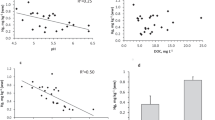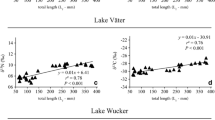Abstract
“Effective non-bicarbonate” buffering capacity (or buffer value) was measured in white muscle of yellow perch (Perca flavescens) by titrations with mineral acid and base in a carbon-dioxide free, closed system. Yellow perch were collected at three month intervals throughout 1983 from an acidic lake (pH ∼ 4.6) and two alkaline lakes (pH ∼ 7.8) in northern Wisconsin. “Buffering capacity” was also determined for white muscle of perch kept in the laboratory under different regimes of temperature and ration. The mean “buffering capacity” of white muscle from yellow perch taken directly from natural environments ranged from 40.7 ± 3.1 (SD) slykes in March of 1983 to 53.7 ± 2.8 (SD) slykes in July of that year. These changes in “buffering capacity” were strongly correlated with water temperature. Egg production and thirty-day laboratory starvation produced significant decreases in “buffering capacity” and increases in the water content of yellow perch muscle. Fed perch in the laboratory had a temperature dependent “buffering capacity” similar to “field caught” fish. “Buffering capacity” of white muscle did not differ between yellow perch from acidic and alkaline lakes. Investigators using “buffering capacity” as a gauge of species differences in metabolic potential, should be wary of seasonal and reproductive factors that might alter their conclusions.
Similar content being viewed by others
References cited
Abe, G., Dobson, G.P., Hoeger, U. and Parkhouse, W.S. 1985. Role of histidine-related compounds to intracellular buffering in fish skeletal muscle. Am. J. Physiol. 249: R449–R454.
Aickin, C.C. and Thomas, R.C. 1977. Micro-electrode measurement of the intracellular pH and buffering power of mouse soleus muscle fibres. J. Physiol. 267: 791–810.
Bate Smith, E.C. 1938. The buffering of muscle in rigor; protein, phosphate, and carnosine. J. Physiol. 92: 336–343.
Black, E.C., Robertson, A., Conner, K., Lam, K.C. and Chui, W.G. 1962. Changes in glycogen, pyruvate, and lactate in rainbow trout (Salmo gairdneri) during and following muscular activity. J. Fish. Res. Board Can. 19: 409–436.
Box, G.E.P., Hunter, W.G. and Hunter, J.S. Statistics for Experiments: An Introduction to Design Data Analysis, and Model Building. New York, N.Y.: John Wiley and Sons, 1978.
Bradford, M.M. 1976. A rapid and sensitive method for the quantitation of microgram quantities of protein utilizing the principle of protein-dye binding. Analy. Biochem. 72: 248–254.
Bridges, C.R., Taylor, A.C., Morris, S.J. and Grieshaber, M.K. 1984. Ecophysiological adaptations inBlennius pholis (L.) blood to intertidal rockpool environments. J. Exp. Mar. Biol. and Ecology. 77: 151–167.
Burton, R.F. 1978. Intracellular Buffering. Respir. Physiol. 33: 51–58.
Cameron, J.N. 1984. Acid-base status of fish at different temperatures. Am. J. Physiol. 246: R452–R459.
Castellini, M.A. and Somero, G.N. 1981. Buffering capacity of vertebrate muscle: Correlations with potentials for anaerobic function. J. Comp. Physiol. 143: 191–198.
Dively, J.L., Mudge, J.E., Neff, W.H. and Anthony, A. 1977. Blood PO2, PCO2, and pH changes in brook trout (S. Jontinalis) exposed to sublethal levels of acidity. Comp. Biochem. and Physiol. 57A: 347–351.
Draper, N. and Smith, H. Applied Regression Analysis, Second Edition. New York, N.Y.: John Wiley and Sons, 1981.
England, W.R. and Baldwin, J. 1983. Anaerobic energy metabolism in the tail musculature of the Australian YabbyCherax destructor (Crustacea, Decapoda, Parastacidea): Role of phosphagens and anaerobic glycolysis during escape behavior. Physiol. Zool. 56 (4): 614–622.
Fry, F.E.J. 1971. Effects of environmental factors on the physiology of fish. Pages 1–98In W.S. Hoar and D.J. Randall, eds. Fish physiology. Vol. III. Locomotion. Academic Press, New York.
Hand, S.C. and Somero, G.N. 1983. Phosphofructokinase of the hibernatorCitellus beeche: Temperature and pH regulation of activity via influences on the tetramer-dimer equilibrium. Physiol. Zool. 56 (3): 380–388.
Heisler, N. 1980. Regulation of the acid-base status in fishes. 1980. Pages 123–162.In M.A. Ali, ed. Environmental physiology of fishes. Plenum Press, New York.
Heisler, N. 1982. Transepithelial ion transfer processes as mechanisms for fish acid-base regulation in hypercapnia and lactacidosis. Can. J. Zool. 60 (5): 1108–1122.
Heisler, N. 1984(a). Acid-Base regulation in fishes. Pages 315–400In W.S. Hoar and D.J. Randall, eds. Fish Physiology. Vol. Xa. Gills: Part A: Anatomy, gas transfer, and acid-base regulation. Academic Press, New York.
Heisler, N. 1984(b). Role of ion transfer processes in acid-base regulation with temperature changes in fish. Am. J. Physiol. 246: R441–R451.
Heisler, N. and Piiper, J. 1971. The buffer value of rat diaphragm muscle tissue determined by PCO2 equilibration of homogenates. Respir. Physiol. 12: 169–178.
Hergenrader, G.L. and Hasler, A.D. 1967. Seasonal changes in swimming rates of yellow perch in Lake Mendota as measured by sonar. Trans. Am. Fish. Soc. 96 (4): 373–382.
Hochachka, P.W. and Mommsen, T.P. 1983. Protons and Anaerobics. Sci. 219: 1391–1397.
Holeton, G.F., Neumann, P. and Heisler, N. 1983. Branchial ion exchange and acid-base regulation after strenuous exercise in rainbow trout (Salmo gairdnere). Respir. Physiol. 51: 303–318.
Ironside, J.I.M. and Love, R.M. 1958. Studies on protein denaturation in frozen fish. I. — Biological factors influencing the amounts of soluble and insoluble protein present in the muscle of the North Sea Cod. J. Sci. Food Agric. 9: 597–604.
Jennings, D.B. and Reeves, R.B. 1983. Commentary on the review article by Dr. Peter Stewart: Modern quantitative acid-base chemistry. Can. J. Physiol. and Pharmacol. 61: 1442–1443.
Johnston, I.A. 1981. Quantitative analysis of muscle breakdown during starvation in the marine flatfishPleuronectes platessa. Cell Tissue Res. 214: 369–386.
Johnston, I.A., Davison, W. and Goldspink, G. 1977. Energy metabolism of carp swimming muscles. J. Comp. Physiol. 114: 203–216.
Lukton, A. and Olcott, H.S. 1958. Content of free imidazole compounds in the muscle tissue of aquatic animals. Food Res. 23: 611–618.
Lykkeboe, G. and Johansen, K. 1975. Comparative aspects of buffering capacity in muscle. Respir. Physiol. 25: 353–361.
Marsh, B.B. 1952. Observations on rigor mortis in whale muscle. Biochim. Biophys. Acta 9: 127–132.
Mill, G.K. and Baldwin, J. 1983. Biochemical correlates of swimming and diving behavior in the little PenguinEudyptula minor. Physiol. Zool. 56 (2): 242–254.
Mommsen, T.P., French, C.J. and Hochachka, P.W. 1980. Sites and patterns of protein and amino acid utilization during the spawning migration of salmon. Can. J. Zool. 58: 1785–1799.
Morris, G.M. and Baldwin, J. 1984. pH Buffering Capacity of Invertebrate Muscle: Correlations with Anaerobic Muscle Work. Mol. Biol. 5: 61–70.
Motohira, T. and Inone, N. 1971. Effect of some chemical compounds on the buffering capacity of horsehair crabErimacrus isenbeckki muscle during intermolt stages. J. Food Sci. 36: 51–54.
Portner, H.O., Heisler, N. and Grieshaber, M.K. 1984. Anaerobiosis and acid-base status in marine invertebrates: a theoretical analysis of proton generation by anaerobic metabolism. J. Comp. Physiol. B 155: 1–12.
Rahel, Frank J. 1983. Population differences in acid tolerance between yellow perchPerca flavescens, from naturally acidic and alkaline lakes. Can. J. Zool. 61 (1): 147–152.
Sandstrom, O. 1983. Seasonal variations in the swimming performance of perch (Perca fluviatifs L.) measured with the rotatory-flow technique. Can. J. Zool. 61 (7): 1475–1480.
Sharp, R.L., Costill, D.L., Fink, W.J. and King, D.S. 1983. The effects of eight weeks of sprint training on the buffer capacity of muscle in man. Med. Sci. Sports Exercise. 15 (2): p. 116.
Shul'man, G.E. Life cycles of fish. Physiology and Biochemistry. New York, N.Y.: John Wiley and Sons, 1974.
Somero, G.N. 1981. pH Temperature interactions on proteins: Principles of optimal pH and buffer system design. Mar. Biol. Lett. 2: 163–178.
Somero, G.N. and Childress, J.J. 1980. A violation of the metabolism-size scaling paradigm: Activities of glycolytic enzymes in muscle increase in larger-size fish. Physiol. Zool. 53 (3): 322–337.
Stewart, P.A. 1981. How to understand acid-base. A quantitative acid-base primer for biology and medicine. Elsevier, New York.
Sullivan, K.M. and Somero, G.N. 1980. Enzyme activities of fish skeletal muscle and brain as influenced by depth of occurrence and habits of feeding and locomotion. Mar. Biol. 60: 91–99.
Sullivan, K.M. and Somero, G.N. 1983. Size and diet-related variations in enzymic activity and tissue composition in the Sablefish —Anoplopoma fimbria. Biol. Bull. 164: 315–326.
Suyama, M., Koike, J. and Suzuki, K. 1958. Studies on the buffering capacity of fish muscle-IV. Buffering capacity of muscles of some marine animals. Bull. Jpn. Soc. Sci. Fish. 24 (4): 281–285.
Turner, J.D., Wood, C.M. and Clark, D. 1983. Lactate and proton dynamics in the Rainbow Trout (Salmo gairdneri). J. Exp. Biol. 104: 247–268.
Van Slyke, D.D. 1922. On the measurement of buffer values and on the relationship of buffer value to the dissociation constant of the buffer and the concentration and reaction of the buffer solution. J. Biol. Chem. 52: 525–570.
White, F.N. and Somero, G.N. 1982. Acid-base regulation and phospholipid adaptations to temperature: Time courses and physiological significance of modifying the milieu for protein function. Physiol. Rev. 62 (1): 40–90.
Wood, C.M., Turner, J.D. and Graham, M.S. 1983. Why do fish die after severe exercise? J. Fish Biol. 22: 189–201.
Wood, J.D., Duncan, D.W. and Jackson, M. 1960. Biochemical studies on Sockeye Salmon during spawning migration XI. The free histidine content of the tissues. J. Fish. Res. Board Can. 17 (3): 347–351.
Author information
Authors and Affiliations
Rights and permissions
About this article
Cite this article
Nelson, J.A., Magnuson, J.J. Seasonal, reproductive, and nutritional influences on muscle “buffering capacity” in yellow perch (Perca flavescens). Fish Physiol Biochem 3, 7–16 (1987). https://doi.org/10.1007/BF02183989
Issue Date:
DOI: https://doi.org/10.1007/BF02183989




